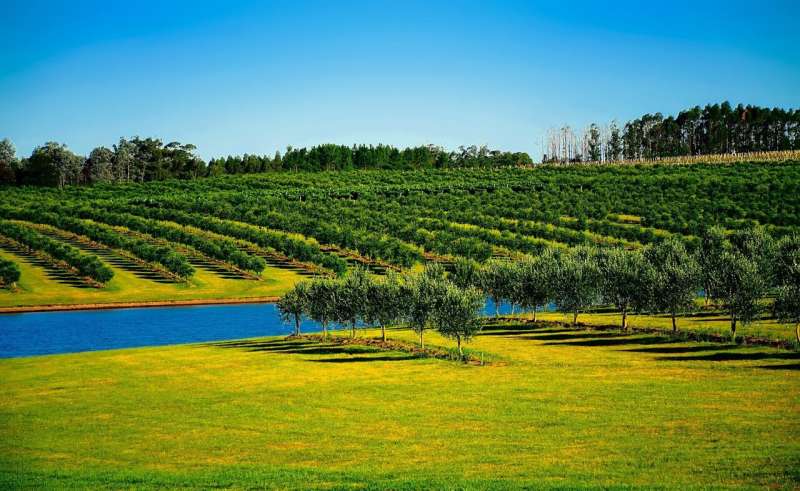This article has been reviewed according to Science X's editorial process and policies. Editors have highlighted the following attributes while ensuring the content's credibility:
fact-checked
peer-reviewed publication
trusted source
proofread
Research catalogs greenhouse gas emissions tied to energy use for interbasin water transfers

Much of the water in the U.S. West is transported across vast geographical areas by large infrastructure projects known as interbasin water transfers. Two of these projects in particular make up 85% of all energy-related greenhouse gas emissions associated with U.S. interbasin transfer—one in Arizona and the other in California—according to the new research published this week in the journal Nature Water.
The project in Arizona is known as the Central Arizona Project, and in California it's the State Water Project.
"You hear a lot about these big projects and how much energy they use," said Avery Driscoll, a doctoral student in CSU's Department of Soil and Crop Sciences and the paper's lead author. "We were curious how much of that was actually attributable to agriculture and what the emissions impact was."
In gathering and analyzing data from 2018 to 2022, Driscoll excluded the portions of interbasin transfers that are used for non-irrigation sources such as municipal water supplies. During the five years of data Driscoll reviewed, approximately 41% of the Central Arizona Project and about 34% of California's State Water Project went to agriculture.
Colorado's largest interbasin water transfer project, the Colorado-Big Thompson project, or CBT, was third on the list. However, it accounted for a much smaller portion of the energy-related greenhouse gas emissions comparatively, roughly 6%. From 2018 to 2022, about 45% of the CBT project, which is operated by Northern Water, was used for agriculture.
Driscoll reviewed data for 106 projects, with the Arizona, California and Colorado projects accounting for 91% of the energy use tied to irrigation from interbasin transfers.
"Although energy use for interbasin transfers is the dominant emissions source in only 15 counties," the study's authors wrote, "the emissions impact is substantial in those locations."
"I was surprised it was so consolidated," Driscoll said. "I think it's also a testament to the fact that a lot of these transfers aren't being used for irrigation because it's expensive. Farmers are not going to pay as much as municipalities for the water, so it's just less feasible to be using trans-basin water for irrigation."
A full irrigation emissions picture
The new paper in Nature Water builds on earlier work by Driscoll and her co-authors published in Nature Communications. That paper catalogued energy use tied specifically to on-farm groundwater pumping in the U.S., which is nearly four times more emissions-intensive than surface water irrigation. Groundwater use accounts for 79% of irrigation-related emissions despite providing only 49% of U.S. irrigation water.
These two papers combined represent the "most comprehensive national-scale analysis of irrigation-related emissions" available, according to the study's authors.
"Irrigation is an essential climate change adaptation strategy, but we're showing here that irrigation presents some important tradeoffs with our greenhouse gas mitigation goals," said CSU Associate Professor Nathan Mueller, a co-author on the study. "On the other hand, irrigation allows for incredible boosts in crop productivity, so we need to recognize the considerable benefits of irrigation while attempting to minimize the greenhouse gas costs."
In addition to water transfer projects, the Nature Water paper also catalogs irrigation-related greenhouse gas emissions associated with groundwater degassing and nitrification. For these two categories, the impact tended to vary greatly based on location.
Groundwater degassing refers to the natural process by which dissolved gases release into the atmosphere after groundwater is applied to a field. The study's authors found that groundwater degassing was "the dominant emissions source in 55 counties (10% of irrigated land), including much of the Lower Mississippi River Valley region."
Irrigating farmland can also cause increased amounts of nitrous oxide, a potent greenhouse gas, to be released into the atmosphere through a natural biological process called denitrification. The study found that nitrous oxide emissions were the dominant source of irrigation-related emissions in only 7% of U.S. counties.
Driscoll and Mueller view this accounting as being applicable in many contexts, including to help inform national emissions and reduction efforts as well as current greenhouse gas accounting frameworks.
"Greenhouse gas emissions from agriculture are complicated because they involve so many different mechanisms, and we found that irrigation-related emissions are no exception," Mueller said. "The good news is that we can address most of these emissions through relatively straightforward changes to our energy and agricultural systems—electrifying and decarbonizing pumping systems along with the grid."
More information: Hotspots of irrigation-related US greenhouse gas emissions from multiple sources, Nature Water (2024). DOI: 10.1038/s44221-024-00283-w
Journal information: Nature Communications , Nature Water
Provided by Colorado State University

















